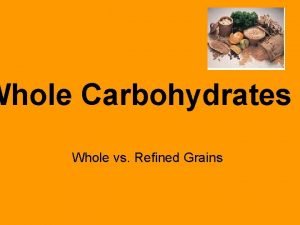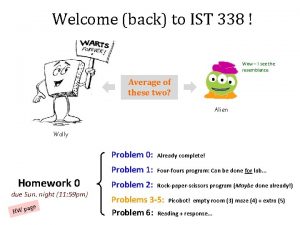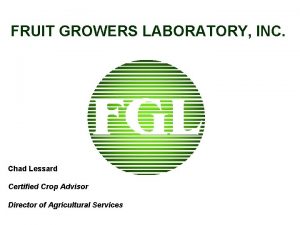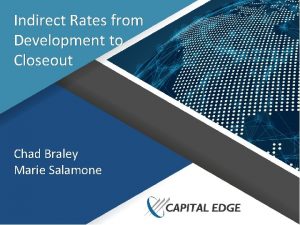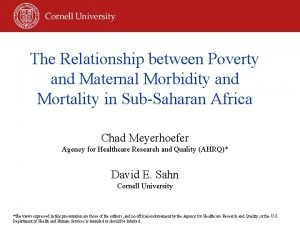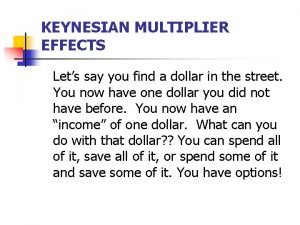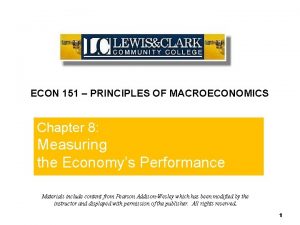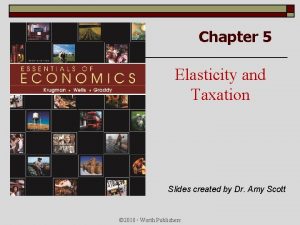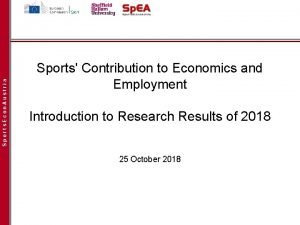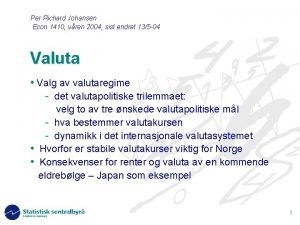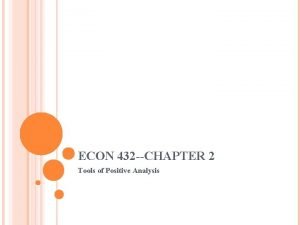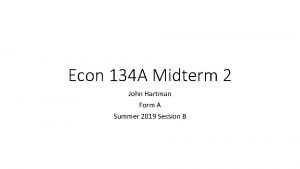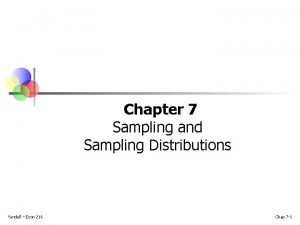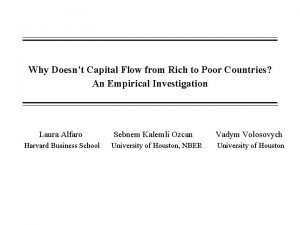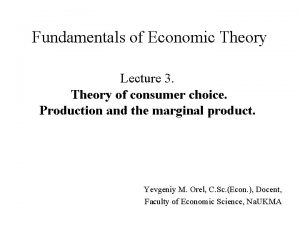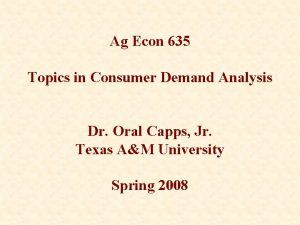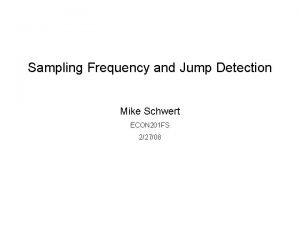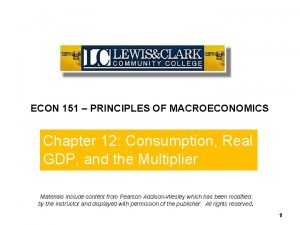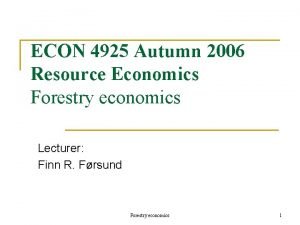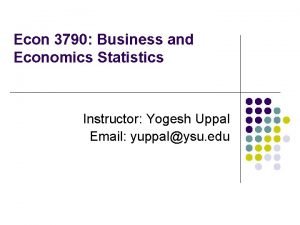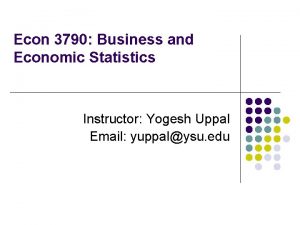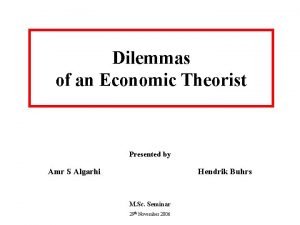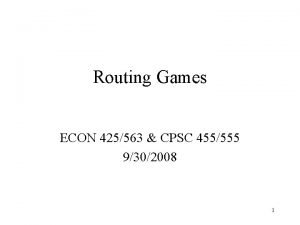ECON 338 C Topics in Grain Marketing Chad



















































































- Slides: 83

ECON 338 C: Topics in Grain Marketing Chad Hart Assistant Professor/Grain Markets Specialist chart@iastate. edu 515 -294 -9911 Econ 338 C, Spring 2009

Today’s Topic Government Programs With a side trip through Tuesday’s USDA Reports Econ 338 C, Spring 2009

Econ 338 C, Spring 2009

Econ 338 C, Spring 2009

Econ 338 C, Spring 2009

Econ 338 C, Spring 2009

Econ 338 C, Spring 2009

Econ 338 C, Spring 2009

Econ 338 C, Spring 2009

Econ 338 C, Spring 2009

Econ 338 C, Spring 2009

Econ 338 C, Spring 2009

Government Intervention in Agriculture Supply Control Conservation Price Support Risk Management Trade Promotion Food Security Econ 338 C, Spring 2009

Farm Bill Titles I. III. IV. V. Commodities Conservation Trade Nutrition Credit Futures VI. Rural Development VII. Research VIII. Forestry Econ 338 C, Spring 2009 IX. Energy X. Hort. & Organic Ag. XI. Livestock XII. Crop Insurance XIII. Commodity XIV. Miscellaneous XV. Trade & Taxes

Farm Bill Projected Spending 2008 -2013 $297 Billion Econ 338 C, Spring 2009

The 2008 Farm Bill ØContinues many of the same programs we have currently ØDirect payments ØPrice countercyclical payments (CCPs) ØMarketing loans ØCRP, EQIP, and other conservation programs ØGives producers a choice on programs ØAverage Crop Revenue Election (ACRE) ØSets up new permanent disaster program ØSupplemental Revenue Assistance Payments Program (SURE) Econ 338 C, Spring 2009

Direct Payments that provide income support to farmers “Fixed” – do not change with agricultural conditions “Decoupled” – do not change with individual decisions Econ 338 C, Spring 2009

Direct Payment Base Payments are based on historical acreage and yields Payment rate is set by law Producers know the exact amount they will receive each year Econ 338 C, Spring 2009

Direct Payment Rates Crop Unit 2008 -12 Corn $/bu. 0. 28 Soybeans $/bu. 0. 44 Barley $/bu. 0. 24 Wheat $/bu. 0. 52 Oats $/bu. 0. 024 Cotton $/lb. 0. 0667 Sorghum $/bu. 0. 35 Econ 338 C, Spring 2009

Direct Payment Example Direct Payment = 83. 3% * Payment Acreage * Direct Payment Yield * Direct Payment Rate $27. 08 = 83. 3% * 116. 1 bu/ac * $0. 28/bu Econ 338 C, Spring 2009

Price Countercyclical Payments that provide income support to farmers “Price Countercyclical” – payment rate changes with season average commodity price Econ 338 C, Spring 2009

Countercyclical Payment Base Payments are based on historical acreage and yields Payment rate changes with price Producers do not know the exact amount they will receive each year Econ 338 C, Spring 2009

Target Price Changes Crop Unit 2008 -09 2010 -12 Corn $/bu. 2. 63 Soybeans $/bu. 5. 80 6. 00 Barley $/bu. 2. 24 2. 63 Wheat $/bu. 3. 92 4. 17 Oats $/bu. 1. 44 1. 79 Cotton $/lb. 0. 724 0. 7125 Sorghum $/bu. 2. 57 2. 63 Econ 338 C, Spring 2009

Loan Rate Changes Crop Unit 2008 -09 2010 -12 Corn $/bu. 1. 95 Soybeans $/bu. 5. 00 Barley $/bu. 1. 85 1. 95 Wheat $/bu. 2. 75 2. 94 Oats $/bu. 1. 33 1. 39 Cotton $/lb. 0. 52 Sorghum $/bu. 1. 95 Econ 338 C, Spring 2009

Countercyclical Payment Rate = Max(0, Target Price – Direct Payment Rate – Max(National Loan Rate, National Season Average Price)) Target Price, Direct Payment Rate, and National Loan Rate are set by Congress Econ 338 C, Spring 2009

Countercyclical Payment Rate = Max(0, Target Price – Direct Payment Rate – Max(National Loan Rate, National Season Average Price)) $0. 29 = Max(0, $2. 63 – $0. 28 – Max($1. 95, $2. 06)) Econ 338 C, Spring 2009

Countercyclical Payment Example Countercyclical Payment = 83. 3% * Payment Acreage * Countercyclical Payment Yield * Countercyclical Payment Rate $29. 52 = 83. 3% * 122. 1 bu/ac * $0. 29/bu Econ 338 C, Spring 2009

Countercyclical Payments Econ 338 C, Spring 2009

Risks in Agriculture At planting time, agricultural producers face two major risks: • Yield uncertainty ØInput application, crop insurance • Price uncertainty ØMarketing strategies and tools Econ 338 C, Spring 2009

Government Sponsored Risk Management Programs Marketing Loan Program ØMarketing Loan vs. Loan Deficiency Payments Crop Insurance ØYield vs. Revenue Insurance Econ 338 C, Spring 2009

Marketing Loan Program Government program meant to provide cash flow support during the marketing year Loans are nonrecourse, this means that the crop can be used as payment for the loan Available for over 20 commodities Econ 338 C, Spring 2009

Loan Rate Changes Crop Unit 2008 -09 2010 -12 Corn $/bu. 1. 95 Soybeans $/bu. 5. 00 Barley $/bu. 1. 85 1. 95 Wheat $/bu. 2. 75 2. 94 Oats $/bu. 1. 33 1. 39 Cotton $/lb. 0. 52 Sorghum $/bu. 1. 95 Econ 338 C, Spring 2009

Marketing Loans and LDPs The program sets rates at the county level by crop Eligible production may either be put under loan or have a loan deficiency payment (LDP) taken on it The amount of the loan or LDP depends on the quantity you wish to use in the program Econ 338 C, Spring 2009

Marketing Loans and LDPs The program is based on the county in which you will store your crop, not the county in which you produce the crop There may be advantages to growing the crop in one county and storing in another Econ 338 C, Spring 2009

Marketing Loans are for 9 months, but can be redeemed at any time To pay back the loan, you may either forfeit the crop as payment or pay an amount set by the minimum of the posted county price (PCP) or the loan rate plus interest Possible to pay back the loan at less than face value Econ 338 C, Spring 2009

Posted County Prices (PCP) Estimate of local market prices Usually based on 2 terminal markets, takes the higher price Terminal prices are adjusted for transportation costs and other factors Econ 338 C, Spring 2009

PCP Calculation Example: Story County, Iowa, Corn 11/10/05 PCP = $1. 40 Econ 338 C, Spring 2009

Loan Deficiency Payments (LDP) Alternative to taking the loan Works like taking the loan and paying it back the same day Can not take the loan and LDP on the same quantity If the PCP is greater than the loan rate, then you can only take the loan Econ 338 C, Spring 2009

LDP Calculation Example: Story County, Iowa, Corn 11/10/05 Econ 338 C, Spring 2009

Loan vs. LDP The loan is like a free put option at the loan rate The loan protects you against downside price movements, but costs you interest if prices exceed the loan rate The LDP exposes you to downside price movements, but there are no interest charges Econ 338 C, Spring 2009

Loan vs. LDP Econ 338 C, Spring 2009

Example Farm A 100 acre corn farm in Story County, Iowa Harvested 180 bushels per acre of corn (18, 000 bushels) Based on market information for 11/10/05 and an expected basis of $-0. 30 Econ 338 C, Spring 2009

LDP and Sell You could take the LDP today and sell on the cash market Return = Cash value of the crop + LDP amount today $34, 920 = $26, 820 + $8, 100 = ($1. 49/bu + $0. 45/bu) * 18, 000 bu Econ 338 C, Spring 2009

LDP and Store You take the LDP today, store the crop until July, and sell on the cash market Return = Cash value of the crop in July + LDP amount today - Storage charges Most risky strategy of the three since you take on all price risk The other strategies limit downside price risk, but at a given cost Econ 338 C, Spring 2009

Revenue Dist. of LDP and Store LDP and Sell Econ 338 C, Spring 2009

Loan and Store You take the marketing loan today and store the crop until July Your return depends on prices in July If prices are below the loan rate, forfeit the crop and keep the loan Return = Loan value Econ 338 C, Spring 2009

Loan and Store If prices are above the loan rate, repay the loan and sell the crop Return = Cash value of the crop - Interest charges - Storage charges Less risky since the loan provides a revenue floor Econ 338 C, Spring 2009

Revenue Dist. of Loan and Store LDP and Sell Econ 338 C, Spring 2009

LDP, Store, and Hedge You take the LDP today, store the crop until July, hedge the cash value of the crop with the July futures contract, and sell on the cash market The hedge is constructed by selling the July futures contract today and buying it in June Econ 338 C, Spring 2009

LDP, Store, and Hedge Return = Cash value of the crop in July + LDP amount today + Return from the hedge - Storage charges This is the least risky strategy since you are locking in a narrow range of values Econ 338 C, Spring 2009

Revenue Dist. with Hedge LDP and Sell Econ 338 C, Spring 2009

Average Crop Revenue Election (ACRE) Ø ACRE is a revenue-based counter-cyclical payment program Ø Based on state and farm-level yields per planted acre and national prices Ø Producers choose between the current price -based counter-cyclical payment (CCP) program and ACRE Ø There are still some details to be worked out about ACRE (stay tuned) Econ 338 C, Spring 2009

Farmer Choice Ø Starting in 2009, producers will be given the option of choosing ACRE or not Ø Can choose to start ACRE in 2009, 2010, or beyond Ø Once you’re in ACRE, you stay in ACRE until the next farm bill Ø If you sign up for ACRE, you must do so for all eligible crops Ø Deadline for sign-up, June 1 of each year (Aug. 14, this year) Ø Producers choosing ACRE agree to 20% decline in direct payments and 30% decline in loan rates Econ 338 C, Spring 2009

ACRE Settings Ø ACRE is based on planted acres Ø Total acres eligible for ACRE payments limited to total number of base acres on the farm Ø Farmers may choose which planted acres are enrolled in ACRE when total base area is exceeded Econ 338 C, Spring 2009

Loan Rates under ACRE Corn $1. 365 Soybeans $3. 50 Current Loan Rates Corn $1. 95 Econ 338 C, Spring 2009 Soybeans $5. 00

Average Direct Payments Per Payment Acre for Iowa Crop Corn Soybeans Current Program 32. 51 ACRE Difference 26. 01 6. 50 15. 71 12. 57 3. 14 Please note the 83. 3 or 85% rule has not been yet to these payments. Econ 338 C, Spring 2009

ACRE Ø Program has state and farm trigger levels, both must be met before payments are made Ø Expected state and farm yield based on 5 year Olympic average yields per planted acre Ø ACRE price guarantee is the 2 year average of the national season-average price Econ 338 C, Spring 2009

ACRE Set-up for Iowa Soybeans Year Yield per Planted Acre (bu. /acre) Year Season-average Price ($/bu. ) 2004 49. 0 2007 10. 10 2005 52. 0 2008 9. 35 2006 50. 5 2007 52. 0 Averag e 9. 73 2008 45. 5 Olympic Average 50. 5 The 2008 yield and price are USDA’s March 2009 estimates. So the expected state yield would be 50. 5 bushels per acre and the ACRE price guarantee would be $9. 73 per bushel. Econ 338 C, Spring 2009

ACRE Structure Ø ACRE revenue guarantee = 90% * ACRE price guarantee * Expected state yield ØFor our example, the ACRE revenue guarantee is 90% * $9. 73/bu. * 50. 5 bu. /acre Ø$442. 23/acre Ø ACRE actual revenue = Max(Seasonaverage price, Loan rate) * Actual state yield per planted acre Econ 338 C, Spring 2009

ACRE Structure Ø ACRE Farm revenue trigger = Expected farm yield * ACRE price guarantee + Producer-paid crop insurance premium ØLet’s assume farm yields equal to state yields and use the average producer-paid crop insurance premium for 2008 Ø 50. 5 bu. /acre * $9. 73/bu. + $17. 58/acre Ø$508. 95/acre Econ 338 C, Spring 2009

ACRE Payment Triggers Ø ACRE actual farm revenue = Max(Seasonaverage price, Loan rate) * Actual farm yield per planted acre Ø Given our example, ACRE payments are triggered when ACRE actual revenue is below $442. 23/acre and ACRE actual farm revenue is below $508. 95/acre Econ 338 C, Spring 2009

ACRE Payments Ø Payment rate = Min(ACRE revenue guarantee – ACRE actual revenue, 25% * ACRE revenue guarantee) Ø Payments made on 83. 3% of planted/base acres in 2009 -11, 85% in 2012 Ø ACRE payment adjustment: Payment multiplied by ratio of Expected farm yield to Expected state yield Econ 338 C, Spring 2009

ACRE Payment Timing Ø Payments can begin as soon as practicable possible after the end of the marketing year ØSo 2009 ACRE payments could start to be paid out in October 2010 ØThere are no provisions for advance payments Econ 338 C, Spring 2009

ACRE vs. CCP pays out No CCP payments No ACRE payments Both pays out ACRE pay Econ 338 C, Spring 2009

Looking Beyond 2009 Ø The ACRE revenue guarantee is updated each year using the same rules Ø 5 year Olympic average for yields Ø 2 year average for prices Ø But the ACRE revenue guarantee can not change by more than 10 percent (up or down) from year to year Ø So if the 2009 ACRE revenue guarantee is $442. 23, then the 2010 ACRE revenue guarantee must be between $398. 01 and $486. 45 Econ 338 C, Spring 2009

An Example for 2009 Ø To start, we need the expected state and farm yields and the ACRE price guarantee Ø Expected state yield Ø Expected farm yield 50. 5 bu/acre 55. 0 bu/acre Ø 2004 -08 Olympic average of yields per planted acre Ø ACRE price guarantee $9. 73/bu Ø Average of 2007 and 2008 season-average prices Ø ACRE Revenue Guarantee $442. 23 Ø 90% * $9. 73/bu * 50. 3 bu/acre Ø ACRE Farm Revenue Guarantee Ø $9. 73 * 55 bu/acre + $20/acre Econ 338 C, Spring 2009 $555. 15

Example (continued) Ø For 2009, we need the actual state yield, the actual farm yield , and the season-average price Ø Actual state yield Ø Actual farm yield Ø Season-Average Price 45 bu/acre 55 bu/acre $9. 00/bu Ø ACRE Actual Revenue $405. 00 Ø $9. 00/bu * 45 bu/acre Ø ACRE Farm Actual Revenue Ø $9. 00/bu * 55 bu/acre Econ 338 C, Spring 2009 $495. 00

Example (continued) Ø State Trigger ØACRE Revenue Guarantee ØACRE Actual Revenue $442. 23 $405. 00 Ø So we’ve met the state trigger Ø Farm Trigger ØACRE Farm Revenue Guarantee ØACRE Farm Actual Revenue Ø So we’ve met the farm trigger Econ 338 C, Spring 2009 $555. 15 $495. 00

Example (continued) Ø ACRE Payment $33. 78 ØMin(25%*$442. 23, $442. 23 – $405. 00) * (55 bu/acre / 50. 5 bu/acre) * 83. 3% Econ 338 C, Spring 2009

Farmer’s Choice Ø In deciding about ACRE, farmers must weigh: ØThe loss of 20% of their direct payments, a 30% drop in the marketing loan rate, and no access to CCP payments versus ØThe potential for payments under ACRE Econ 338 C, Spring 2009

Comparing Program Parameters Ø For Iowa Soybeans ØUnder the current CCP program ØCCP Yield Average = 38. 5 bushels per acre ØCCP Effective Target Price = $5. 36/bushel ØIn our example, for ACRE ØACRE Yield Guarantee = 50. 5 bushels per acre ØACRE Price Guarantee = $9. 73/bushel Ø 20% of average Iowa soybean direct payment = $3. 14 per acre Econ 338 C, Spring 2009

Factors to Consider Ø ACRE looks more attractive if: Ø You think prices will fall in the future, but stay above the current loan rates Ø Markets continue to show higher price volatilities Ø Current programs look more attractive if: Ø You think prices will rise in the future Ø Potentially no ACRE payments combined with cut in direct payments Econ 338 C, Spring 2009

Supplemental Revenue Assistance Payments Program (SURE) Ø Provides payments to producers in disaster counties for crop losses Ø Based on crop insurance program, noninsured crop assistance program, and disaster declarations Ø Whole-farm revenue protection, not commodity-specific Econ 338 C, Spring 2009

SURE Triggers Ø Declared “disaster county” by Secretary of Agriculture or contiguous to one Ø Farm with losses exceeding 50% of normal production in a calendar year Econ 338 C, Spring 2009

Iowa SURE Eligibility in 2008 Econ 338 C, Spring 2009

SURE Settings Ø Participation and revenue guarantee tied to crop insurance Ø Farm revenue, including some government payments, used to determine payment Ø Payments set as 60% of the difference between guarantee and actual revenue ØLimited to $100, 000 per producer ØPayments not known or paid until the end of the marketing year Econ 338 C, Spring 2009

SURE Guarantee Ø Farm guarantee is the sum of Ø (115 or 120)%*Crop insurance price election*Crop insurance coverage level*Planted acres* Max(APH or CCP yield), for insurable commodities Ø (120 or 125)%*NCAP price election*Planted acres* Max(NCAP or CCP yield), for non-insurable commodities Ø For an individual crop, the guarantee can not be greater than 90% of the crop’s expected revenue Econ 338 C, Spring 2009

SURE Expected Farm Revenues Ø Expected farm revenue is the sum of ØMax(APH or CCP yield)*Planted acres*100% of the crop insurance price for insurable commodities Ø 100% of NCAP yield*100% of NCAP price*Planted acres for non-insurable commodities Econ 338 C, Spring 2009

SURE Actual Farm Revenues Ø Actual farm revenue is the sum of ØHarvested acres*Farm yield*National seasonaverage price for all commodities Ø 15% of direct payments ØAll CCP or ACRE payments ØAll marketing loan benefits ØAll crop insurance or NCAP payments ØAny other disaster assistance payments Econ 338 C, Spring 2009

SURE Payments Ø Payments set as 60% of the difference between farm guarantee and actual farm revenue Ø Payments limited to $100, 000 per producer Ø Payments not known until end of marketing year Econ 338 C, Spring 2009

Payment Limitations Ø Direct payments: $40, 000 (w/o ACRE) $32, 000 (w/ ACRE) Ø Counter-cyclical payments: $65, 000 Ø ACRE: $73, 000 ($65, 000 + $8, 000) Ø Marketing loans: No limits Ø SURE: $100, 000 Ø Direct attribution of payments Econ 338 C, Spring 2009

Summary of Programs Ø Direct payments – Crop-specific income support Ø Counter-cyclical payments – Crop-specific price support Ø ACRE – Crop-specific revenue support Ø Marketing loans – Crop-specific price support Ø SURE – Whole-farm revenue support Econ 338 C, Spring 2009

Class web site: http: //www. econ. iastate. edu/classes/econ 338 C/Hart/ See you next week! Econ 338 C, Spring 2009
 What are refined grains
What are refined grains Responsibilities
Responsibilities Mc 338 tanker
Mc 338 tanker P 338
P 338 500 - 338
500 - 338 How to copy an image on a mac
How to copy an image on a mac Chad b swim helping verbs
Chad b swim helping verbs Vtg gps
Vtg gps Rytmekontrol
Rytmekontrol Chad ulven
Chad ulven Wiu gis
Wiu gis Based sigma chad
Based sigma chad Chad topaz
Chad topaz Chad ostlund
Chad ostlund Chad posner
Chad posner Addi vs chad
Addi vs chad Fruit growers laboratory
Fruit growers laboratory Chad blight
Chad blight Chad rikansrud
Chad rikansrud Chad braley
Chad braley Gordon saxe
Gordon saxe Chad gifford columbia
Chad gifford columbia Chad gestson salary
Chad gestson salary Chad meyerhoefer
Chad meyerhoefer Difference between rill erosion and gully erosion
Difference between rill erosion and gully erosion Chad kessens
Chad kessens Chad imperialism
Chad imperialism Chad eggerman
Chad eggerman Digital marketing topics
Digital marketing topics International marketing topics
International marketing topics Global marketing topics
Global marketing topics Multiplier effect formula
Multiplier effect formula Ib economics fiscal policy
Ib economics fiscal policy Flipitecon
Flipitecon Econ 151
Econ 151 Midpoint method formula
Midpoint method formula Mpc and gdp
Mpc and gdp Marginal analysis in economics
Marginal analysis in economics Sports econ austria
Sports econ austria Econ 1410
Econ 1410 Econ 424
Econ 424 Mr darp econ
Mr darp econ What is game theory
What is game theory Econ 432
Econ 432 Econ 134
Econ 134 Econ
Econ Econ chapter 7
Econ chapter 7 Econ muni harmonogram
Econ muni harmonogram Gertler econ
Gertler econ Quantity theory of money economics
Quantity theory of money economics Econ
Econ Econ
Econ Econ
Econ Nthu econ
Nthu econ Sports econ
Sports econ Econ
Econ Econ 206
Econ 206 Econ 152
Econ 152 Econ
Econ Roy's identity
Roy's identity Scheinův model organizační kultury
Scheinův model organizační kultury Econ
Econ Econ 25
Econ 25 Exclusive ownership of a key resource
Exclusive ownership of a key resource Econ ra twitter
Econ ra twitter Muni thesis
Muni thesis Econ 151
Econ 151 Econ
Econ Prime econ
Prime econ Dan quint
Dan quint Econ
Econ Econ
Econ Econ
Econ Econ
Econ What is forecast bias
What is forecast bias Econ
Econ Econ
Econ Econ
Econ Econ
Econ Economists assume that firms seek to
Economists assume that firms seek to Econ
Econ Kafu wong
Kafu wong Econ
Econ Econ
Econ
